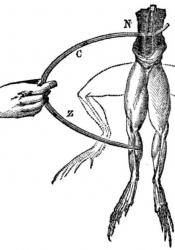Galvanism
In the late 18th century, an Italian physician, physicist, biologist and philosopher named Luigi Galvani discovered Galvanism, it is the application of electric current to living or non-living tissue of an organic matter. He suggested that the electricity was generated from the animal's muscular and nervous systems by observing the twitching responses of a pair of dead frog legs when exposed to a metal or magnetic alloy and electrically connected with an electrolyte. From this it is hypothesized that "galvanism" can revive dead tissue and possibly restore life. Electricity was a new discovery in the late 18th century, so it is understandable why Luigi Galvani made a wrong assumption, but it was appropriate for the circumstances at that time. The same goes for thinking that you can use electricity to bring the dead back to life. It was this supernatural element that attracted Mary Shelly, causing her to include Galvanism in her story, as a huge discovery for Victor Frankenstein, which he learned and applied to his project that later changed his whole life.
MLA Works Cited Entry
Magazine, Smithsonian. “How Twitching Frog Legs Helped Inspire 'Frankenstein'.” Smithsonian.com, Smithsonian Institution, 4 Dec. 2015, https://www.smithsonianmag.com/smart-news/how-twitching-frog-legs-helped....
“Galvanism.” Wikipedia, Wikimedia Foundation, 3 Dec. 2021, https://en.wikipedia.org/wiki/Galvanism.
“Not Even Past: Social Vulnerability and the Legacy of Redlining.” History Engine 3.0, https://historyengine.richmond.edu/episodes/view/4808.

